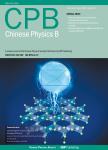Engineering of electronic and optical properties of ZnO thin films via Cu doping
Engineering of electronic and optical properties of ZnO thin films via Cu doping作者机构:Key Laboratory for Electronic Materials of the State National Affairs Commission of PRC School of Electrical Engineering Northwest University for Nationality Department of Physics and Key Laboratory for Radiation Physics and Technology of Ministry of Education Sichuan University
出 版 物:《Chinese Physics B》 (中国物理B(英文版))
年 卷 期:2013年第22卷第4期
页 面:491-494页
核心收录:
学科分类:08[工学] 080501[工学-材料物理与化学] 0805[工学-材料科学与工程(可授工学、理学学位)] 0704[理学-天文学]
基 金:Project supported by the Natural Science Foundation of Gansu Province, China (Grant No. 0803RJZA008) the Fundamental Research Funds for the Central Universities, China (Grant No. zyz2012057) the National Natural Science Foundation of China (Grant No. 11004141) the Program for New Century Excellent Talents in University, China (Grant No. 11-0351)
主 题:ZnO thin films Cu doping optical properties bandgap tuning
摘 要:ZnO thin films doped with different Cu concentrations are fabricated by reactive magnetron sputtering technique. XRD analysis indicates that the crystal quality of the ZnO:Cu film can be enhanced by a moderate level of Cu-doping in the sputtering process. The results of XPS spectra of zinc, oxygen, and copper elements show that Cu-doping has an evident and complicated effect on the chemical state of oxygen, but little effect on those of zinc and copper. Interestingly, further investigation of the optical properties of ZnO:Cu samples shows that the transmittance spectra exhibit both red shift and blue shift with the increase of Cu doping, in contrast to the simple monotonic behavior of the Burstein–Moss effect. Analysis reveals that this is due to the competition between oxygen vacancies and intrinsic and surface states of oxygen in the sample. Our result may suggest an effective way of tuning the bandgap of ZnO samples.



